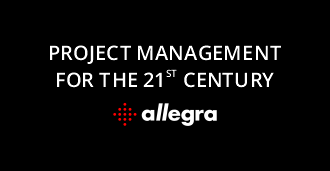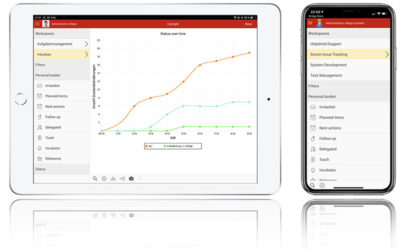Ticket system: Comparison and test 2021
Overview
A ticket system enables the systematic handling of problems that customers or one’s own staff have with a product or service.
There are well over a hundred free and commercial solutions, of which we have tested those with a German user interface. The ones we liked best are presented here in alphabetical order.
- Allegra
- Axios
- Bold360
- Deskero
- DeskPRO
- Freshservice
- HEAT ITSM
- Leaddesk
- LiveZilla
- ManageEnginde
- ORTS
- Request Tracker
- SolarWinds MSP
- Spiceworks
- Sugester
- TecArt – Trouble Ticket System
- TicketXpert
- Track-it!
- UseResponse
- Zammad
- Zendesk
- ZupportDesk
Allegra – Ticket system
Allegra convinces at first sight with a modern and clear interface. An attractively designed dashboard informs about existing tickets, their processing status and the last actions. The software is easy to use, beautiful and intuitive. Tasks can be grouped according to a wide variety of criteria and can be assigned to other employees via drag & drop.
Clean and chic user interface
As a special feature, Allegra offers its own web application for the customer. This is kept extremely simple and makes it easy for customers to enter and track tickets.
Allegra offers working time tracking, automatic assignment of organizational affiliation based on the email domain, the ability to split tickets, and a fast full-text search that also indexes attachments.
Own hosting via Cloud
Allegra, which was developed in Java and JavaScript, offers installation packages for Windows and Linux and is available as a Docker container.
The ticket system can be integrated into existing system environments via a REST API. It is also possible to integrate databases from other systems, such as CRM or ERP, into Allegra.
Those who do not want to install Allegra on their own servers can rent a cloud solution from Steinbeis GmbH & Co. KG to rent a cloud solution. According to the manufacturer, hosting takes place in a certified data center in Germany, and all data is managed in compliance with DSGVO.
The prices for the cloud solution are fair: depending on the number of users and the desired range of functions, they range from 10 euros (Starter) to 150 euros (Enterprise). In return, the customer receives a complete, ready-to-use solution on their own dedicated server.
Conclusion
New support solution with great potential
Allegra makes a very good impression at first glance: the interface is sleek and intuitive, updates are released every four weeks, the integration of social platforms corresponds to today’s communication behavior, and the integration options with other platforms are impressive. Users should be aware, however, that the software is still under construction – with all the limitations and error possibilities that can result from this. For example, no workflows are currently possible, and standard features such as automatic link conversion of an entered ticket number (e.g. #48011 becomes a link to the respective ticket) are also missing.
The advantages of Allegra at a glance:
Four-weekly releases/updates
modern and user-friendly interface
strong integration of the social web/ modern forms of communication
Integration options for Asterisk, FreeSWITCH, sipgate.io, GitHub, GitLab, JIRA, Nagios, Icinga and Slack.
Disadvantages:
Software is new and “under development”
Not (yet) suitable for enterprise customers
According to its own statement, Allegra is aimed at small to medium-sized companies with up to 25 support staff. They can expect a very intuitive help desk solution that scores particularly well in the area of social media service requests.
OTRS – Ticket system
With more than 160,000 installations in more than 38 languages, ((OTRS)) Community Edition is the leading open source ticket and help desk system. It is available in three different versions: ((OTRS)) Community Edition, OTRS Business Solution ™ and the hosted OTRS Business Solution ™ Managed. You can find a comparison of each version here.
With the Community Edition (OTRS) you can customize your requirements, from simple tickerecording for incident reporting to support for ITIL processes Incident, Problem, Change Management and Request Fulfillment. Of particular note is the standalone IT Service Management module OTRS :: ITSM, currently available in version 5. Tickets can be created via email, phone, customer web frontend, fax, chat and SMS channels (the last two are only available in OTRS Business Solution ™).
The individual functions that can be accessed via the web interface are implemented as separate modules, so that the ((OTRS)) Community Edition can be extended by currently 44 available functions. The web interface itself has its own template language (Dynamic Template Language, DTL), which enables flexible data output. The open source software is freely available under the Affero General Public License V3 (AGPL).
Customer Dashboard troubleshooting via video
Since version 5s (released last November), ((OTRS)) Community Edition has integrated calendar functionality and WebRTC-based video communication (“EasyConnect”). The latter allows customers to connect directly to a browser with a helpdesk agent.
The StayOrganized calendar not only manages team appointments, but also links appointments and tickets and enables central deployment planning. As a result, the ticket system evolves into a solution for all service management tasks.
Through the Ready2Adopt module, process templates for standardized workflows of incidents, orders, room reservations, vacation requests, travel expense reports or similar processes can be created in version 5. It can integrate information from tools such as JIRA and Bugzilla.
Thanks to the generic interface, many third-party systems such as enterprise resource planning or customer management systems can be connected via SOAP and REST. The system can also be integrated via the i-doit / ((OTRS)) Community Edition Connector to the i-doit IT documentation software, and the i-doit / openITCOCKPIT Connector enables connection to the openITCOCKPIT monitoring system. The diverse connections enable integrated service management.
Improved security through PGP and S / MIME
Security has also been improved: tickets are now signed / encrypted with PGP or S / MIME and outgoing emails are encrypted. Certificates can be stored in OTRS or in an LDAP directory. Two-factor authentication for higher login security was already introduced with version 5.
Many of the new features described above are not available in the free version, but only in the paid business version.
Function overview
Knowledge management by knowledge base
Reminders / Escalation
Automation / Processes / Workflows
Configurable notifications
Dynamic field database: display of data from external ERP / CRM systems
Report generator for PDF statistical reports
The advantages of the ((OTRS)) Community Edition:
Very versatile configuration options (OTRS AG speaks of 1,441 possibilities)
High integration capability through generic interface via SOAP and REST.
Enterprise-ready: Several thousand tickets per day that can be handled by any number of agents
Good acceptance by users
Disadvantages:
Not insignificant learning curve
Many useful features are only available in the paid Business Solution ™
Poor documentation
Request Tracker – Ticket system
In the fall of 2015, the rather quiet help desk market raised a murmur: the company Cape IT announced that it was planning to develop a fork of the ticketing system OTRS. From Cape IT’s point of view, the reasons were quality weaknesses in the development of OTRS, lack of insight into the long-term product roadmap and the question of product availability against the background of the cloud-oriented OTRS Business Solution.
OTRS-fork premiered at CeBIT
At CeBIT 2016, KIX (based on OTRS 5) was presented to the public for the first time. Since then, a lot has happened with the product, which is currently in version 17.0.1. The ticket system can be used both in the company (on-site) and in the KIX ManagedCloud. Cape IT wants to further develop KIX so that the software becomes completely independent of OTRS. This will make Bad Homburg OTRS AG another open source competitor alongside Allegra.
KIX is released under the GNU AGPL V3. The system offers Windows installers for all common Linux distributions (Debian / Ubuntu, RHEL / CentOS, openSUSE and even SELinux). It cooperates with database systems PostgreSQL, MariaDB, MySQL, Oracle and in connection with Windows Server MSSQL Server.
The company version KIX Professional includes the following modules:
Order management
Error management
Service contracts / service catalog
Knowledge management
Device DB / CMDB
KIX Professional MRO (Maintenance, Repair, Overhaul) is available especially for technical field service. This version, which won the industry award “BEST OF 2017”, not only covers the functional scope of KIX Professional, but also the entire maintenance and service planning for machines, production plants or tools. The differences between the KIX, KIX Professional and KIX Professional MRO versions can be found in this overview.
Advantages
KIX is a full-fledged ticket system based on the established open source market leader OTRS. The MRO version with special features for manufacturing companies is interesting. KIX offers ITIL-compliant workflow management and additional modules for a Kanban card and basic IT protection. At Cape IT you get long-term support for the commercial version KIX Professional.
Disadvantages
Although the OTRS fork has attracted some attention and convinces with its functionality, the customer base is not very large. According to the vendor, there were 40 KIX Professional installations and “several hundred” KIX installations at the end of 2016. So the great escape route from OTRS to its promised better brother has not happened – but only 13 months have passed since the market launch. KIX’s future viability, therefore, has yet to be seen. It will take some time from the establishment of a fork to the completion of a separate product.
Request Tracker
Request Tracker (abbreviated as RT) is an old hand among open source help desk systems. Since 1996, the solution programmed in Perl has been developed by Best Practical Solutions LLC. Large top 100 companies such as NASA, Nike or Merrill Lynch rely on the free ticket system. In Germany, RT is particularly popular in the support area with hosters and software manufacturers.
Disadvantages of Request Tracker
Complex installation
The current version 4.4 of 2016 requires the latest versions of many Perl modules. Since they themselves require certain releases of other Perl components, all required modules must be loaded from the CPAN and compiled. But even then, the installation does not capture all dependencies, although the installer reports success. Finding out the missing packages and integrating them by hand requires knowledge of the web server configuration. Including the Google search, it takes several hours until the request tracker is ready for use.
Advantages of Request Tracker
Key feature: Encryption
Unlike other ticketing systems, RT offers seamless integration with PGP. PGP support allows users to encrypt, decrypt, verify and sign incoming and outgoing emails.
This even goes so far that RequestTracker can also send encrypted mails to all RT users, i.e. when an encrypted mail arrives in the system and is to be forwarded to specific users, RT decrypts the message and sends it to the appropriate users – encrypted with their respective keys. It is even possible for Request Tracker to receive replies and comments from RT users via email, since if the email is correctly signed (and optionally encrypted), the system can be sure that the email originated from the particular user and not from someone else.
However, the encryption feature has a small stumbling block: request tracker can be PGP inline or PGP / MIME. Depending on what the user configures in RT, problems will occur with the other format.
Request Tracker Update Ticket
Automation through scripts
A special feature that makes RT particularly interesting are the so-called scripts (no typos!). They assign a certain sequence of actions to events in the ticket system. The spectrum of functions ranges from the automatic sending of mails to the mapping of workflows. A new scrip clicks on the RT user in the web interface. Scripts themselves consist of ordinary Perl code and provide access to the entire RT API.
Differentiated rights assignment
Request Tracker offers many configuration options, for example, differentiated rights assignment for users. Access can be controlled separately for queues and problem categories. Groups group multiple users. User groups can themselves be members of other groups, so that a hierarchical permission structure can be displayed. However, this carries the risk of conflicting definitions.
Overview on many tickets
All serious ticket systems have a search function, but few give the user as many options as Request Tracker to keep track of many tickets. After logging in, the user is taken to the “RT at a glance” page, where they can find the ten highest priority tickets or the ten most recent requests, depending on their settings.
RT also offers the possibility to merge tickets. But beware. This step cannot be undone via the web interface, but only by directly manipulating the SQL database.
Evaluation: Solid oldie, a bit out of date
Request Tracker is not difficult to use, but not very intuitive. In many cases, this is just due to the German translation: sometimes common terminology has been unnecessarily Germanized, while other elements have simply been overlooked.
Many of RT’s once-innovative features are now taken for granted, such as assigning them to different editors, identifying incoming emails, or reporting events via email, such as completing a request. Request Tracker offers solid functionality, but no innovative concepts like integrating social media channels with Allegra.
When the user marks tickets as deleted (or sets them to “deleted” status), they still remain in the database and can only be found using the normal search functions. The main reason for this is that RT’s database structure does not allow tickets to be simply deleted from the database. As a result, the size of the database grows steadily and certain operations (e.g. full-text search) become increasingly cumbersome.
Some users like it when such bugs are forgiven in open source programs, but in the case of Request Tracker the question arises whether the software can still be called “enterprise grade”.
Request Tracker – Overview
The advantages at a glance:
Enterprise-ready (e.g. Kühne & Nagel Logistics, 20,000-70,000 tickets / day)
Extensively designed user interface
PGP support
Several hundred available extensions
The disadvantages:
Tedious and time-consuming installation
Strongly U.S. oriented, e.g. only available outside the U.S.
Long development cycles
Further Information – Ticket system
Other articles on the topic of ticketing systems include issue tracking in product lines, helpdesk software on the go, ITIL applications and ITIL processes. You can also read our reviews on other task management software providers. For this we have taken a close look at Monday, Meistertask, Stackfield and Trello.




